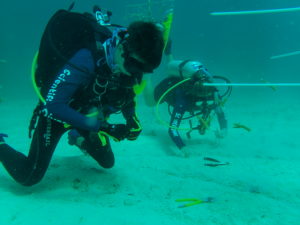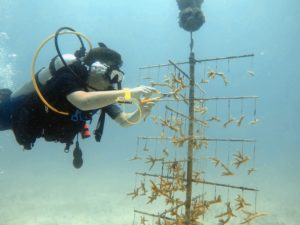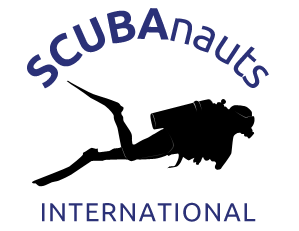The Keys are an extremely fun place to dive and explore. They are even more fun to do those things with SCUBAnauts International. Fortunately for me, this is my second trip with these wonderful divers. Since this is my second trip, I know more people and am much more comfortable in the water, which makes the trip even better.

Second Class Naut Logan and his dive buddy prepare coral fragments to hang on a coral tree in Mote Marine Lab’s nursery off Summerland Key.
Our first day was a bunch of proficiency dives that consisted of skills that divers have to do all the time, such as a regulator recovery and working on our buoyancy and trim. Once everyone in our group felt comfortable, we got to start practicing our science, which was made up of coral and parrot fish identification. We have to be very confident on our coral identification, because our research goes to Mote Marine Laboratory and other research partners. Our research involves finding coral that has a disease called stony coral tissue loss disease (SCTLD), and then we had to identify the type of coral it is using its scientific name.
Coral Restoration Key to Reef Revival
We also help Mote fragment coral and hang it on PVC “trees,” outplant coral, and ham down anchors. The anchors we hammer are used to hold down the coral trees that Mote uses for their coral propagation. We did all these activities for the next three days, unless we were put on our own personal boat called “Moonshine”, where we did parrot fish and coral surveys for a Masternaut project, along with looking for whale sharks that had been sited near Looe Key Reef which is the reef we were diving on.

Nauts hang coral fragments on trees to help them grow faster and prepare to replant them on the reef.
A Masternaut project is a project that a naut does to get the highest rank in SCUBAnauts called the Masternaut. This project requires a certain amount of community service hours and chapter hours, 100 lifetime dives, advanced, nitrox and rescue diver certifications, and a capstone research project that end with a written paper and presentation.
On the third day of diving we outplanted staghorn coral from the nursery back to the reef, and finished all 720 in two dives, so we got to go to one of the old outplanting sites and look around to see what was around there. This was a very special dive, because this reef was named after a former SCUBAnaut and it was also one of my fellow naut’s 100th dive. So far, I have had a lot of fun and we are barely halfway through with 13 out of our 22 dives in seven days.
— Logan M., 2nd Class Naut, Sarasota Chapter

